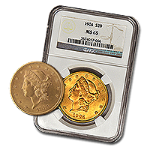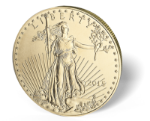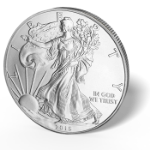This question may seem rather simple, but it is not. Perhaps centuries ago in an economy that still used gold coins to effect everyday commerce, perhaps the term “common” could be more readily applied to the words “gold coin”. Today however, in the United States, most of us have never seen a gold coin, much less carried around a small purse full of them. If you tighten the focus of the words “common date gold coin” to include only U.S. gold coins, then due to excellent records kept by the United States Mints, defining a U.S. common date gold coin is much simpler.
U.S. Mints
There have been a total of eight U.S. Mints that have produced coins of gold, silver, and other metal alloys over the two-plus centuries that the U.S. Mints have been in operation. The First U.S. Mint was built in Philadelphia, then the Capital of the U.S., in 1792. Though the Philadelphia Mint has burned been demolished and rebuilt, and was at one time powered by a steam engine, the Philadelphia Mint in it’s current form still produces U.S. Coinage to this day, along with U.S. Mints located in San Francisco, Ca., Denver, Co., West Point, N.Y.
Buy Rare US Gold Coins
The Philadelphia Mint
The Philadelphia Mint has produced more coins than any other U.S. Mint, and back in it’s heyday it usually produced more gold coins than any other mint as well. For instance, in 1904 the Philadelphia Mint alone produced more than 6.2 million $20 Liberty gold coins. Never before had that many $20 Liberty gold coins been minted in a year’s time. Other years of unusually high production for the minting of the $20 Liberty at the Philadelphia Mint include 1851 and 1852, when more than 2 million were produced each year.
Because of the sheer span of time that the Philadelphia Mint has been making United States coinage, many coins that are considered common date, due to their unusually high production numbers of a given year, were produced by the Philadelphia Mint. But by no means however is every coin, gold or otherwise, produced by the Philadelphia Mint common. For instance, in 1905 the Philadelphia Mint produced under sixty-thousand gold Double Eagle coins while the San Francisco Mint struck over 1.8 million of these coins.
The San Francisco Mint
The San Francisco Mint was opened in 1854 in order serve the miners that were striking gold up and down the State of California. As the gold rush continued and intensified, the San Francisco Mint would set production records for the large Double Eagle gold coin as well as gold coins of smaller denominations. By the end of the gold coin production run in the United States, which could be seen as the mid 1920’s until 1933, The San Francisco Mint was still routinely minting $20 Double Eagle gold coins by the millions, as was the Philadelphia Mint. For this and other reasons, Common Date $20 Saint-Gaudens gold coins which were produced in the 1920’s are either from the Philadelphia or San Francisco Mints. Common Date 1907 and1908 Saint-Gaudens Double Eagle coins were only minted in Philadelphia.
New U.S. Mints Are Established By Congress
Throughout the growth of the United States, U.S. Mints were established when and where they were needed to help promote commerce in United States Dollars and provide the necessary currency. The U.S. Mints were also essential in assaying and coining the immense quantities of gold and silver that the miners were busy bringing to the surface in different areas of the Nation.
The Carson City U.S. Mint
For example, the Carson City, Nevada U.S. Mint was built and opened to coin and monetize the vast amounts of silver that was being produced. A similar situation resulted in the creation of the Dahlonega, Georgia Mint, although in the case of Dahlonega, gold surpluses spurred along the need for a new U.S. Mint branch.
The Carson City Nevada Mint was in use from 1870 - 1885, and again from 1889 - 1893. The Carson City Mint did also coin small amounts of gold coins, but it is primarily known for it’s Silver Dollars which it produced by the tens of millions and for this reason Common Date Silver Dollars may bare the “CC” mintmark that is displayed by all coins struck at the Carson City facility.
The Dahlonega, Georgia U.S. Mint
The Dahlonega, Georgia Mint was in use from 1836 through 1861. The Mint Act of 1835 created the Dahlonega Mint,the Charlotte Mint, and the New Orleans Mint all in one fell swoop. The Act also determined that the Dahlonega Mint would only produce gold coins. Because Dahlonega was only open for a few years, and because they produced relatively few gold coins, the “D” mintmark that at onetime designated the Dahlonega, Georgia Mint signifies a rare gold coin, and none of the coins produced at this facility can be considered “Common Date”. If you have any gold coins from the Dahlonega, Georgia U.S. Mint and you are curious about coin populations, known coins in a particular grade, or would like to have your loose Dahlonega Mint gold coin authenticated and graded, please call ITM Trading at 1.888.696.4653.
The New Orleans, Louisiana U.S. Mint
Along with these U.S. Mints one should also mention the New Orleans, Louisiana U.S. Mint. Like the U.S. Mints in Carson City and Dahlonega, The New Orleans Mint was opened when demand was high, and then closed when the larger U.S. Mints could satisfy the minting and monetary needs of the growing and sprawling Nation.
The New Orleans Mint functioned from 1838 - 1861 and again from 1879 - 1909. The Mint was closed and guarded during much of the Civil War and the ensuing reconstruction period. There were two reasons in particular that the New Orleans Mint was so important during it’s operation; for one, New Orleans was a port city located on the Mississippi River, and this meant that from this U.S. Mint coinage could be distributed quickly to the cities serviced by the port and river. In addition, The New Orleans Mint coined money from both gold and silver, whereas other U.S. Mints were only equipped to press gold coins. The fact that New Orleans was a major producer of silver U.S. coinage does mean that some silver Common Date Coins will bear the “O” mintmark that signifies that the coin was struck at the New Orleans facility.
The Charlotte, North Carolina U.S. Mint
The Charlotte U.S. Mint is perhaps the least known of all the U.S. Mints. It was created under the same legislation that created the New Orleans and Dahlonega Mints. Because the Charlotte Mint produced just over 1.2 million coins during it’s official designation as a U.S Mint from 1837 until North Carolina seceded from the United States in May of 1861, all of the coins that bare the “C” mintmark, which denotes that the coin was struck at the Charlotte Mint, are considered rare. No Common Date gold coins will bare the Charlotte mintmark, in fact any date gold coin produced at the Charlotte Mint should be submitted for authentication and grading. If you have one of these coins and you have questions about it, please contact ITM Trading at 1.888.OWN.GOLD.
The Denver, Colorado and West Point, New York U.S. Mints
The Denver and West Point U.S. Mints are like the Philadelphia and San Francisco Mints in the fact that they are still operating and producing coins to this day. The Denver Mint does have some historical peculiarities to it. For instance, though the Mint was technically established by an Act of Congress in 1862, the first coin was not minted in Denver until 1906.
During this span of forty plus years, the Denver Mint was for all intensive purposes run as a private firm and probably generated profits while being supported by the U.S. Government. Rather than produce coins, the Denver Mint would assay, refine, pour into ingots, and mark with the weight and purity gold that was brought to them by individuals and companies. These gold castings were not and are not considered official U.S. currency, but they do have historic and collectible value above and beyond the value of the gold itself.
With respect to the Denver Mint’s production of $20 Saint-Gaudens gold pieces, the years of highest production were 1923, 1924, and 1925 when 1.7 million, 3.05 million and 2.83 million $20 Saint-Gaudens Double Eagles were respectively coined. Though these numbers were high, they were dwarfed by the 8.8 million $20 Double Eagle gold coins that the Philadelphia Mint pressed in 1928, which is the most Common Date for the large 1 oz. gold coin.
1925 when 1.7 million, 3.05 million and 2.83 million $20 Saint-Gaudens Double Eagles were respectively coined. Though these numbers were high, they were dwarfed by the 8.8 million $20 Double Eagle gold coins that the Philadelphia Mint pressed in 1928, which is the most Common Date for the large 1 oz. gold coin.
The Denver Mint would go on to produce coins of more common metals such as copper and zinc, and unlike other U.S. Mints such as New Orleans Georgia, never ceased producing coins once it began. In fact the U.S. Denver Mint has the distinction today of having produced more coins than any other mint on the planet.
The U.S. Mint in West Point, New York has a very storied and unusual history when compared to the other U.S. Mints. For instance, this Mint began its service as a bullion depository back in 1937. By this point in American History, gold coins were no longer being produced as currency for the people of the United States because President Franklin Roosevelt had issued Executive Order 6102 which demanded that the people turn in their gold coins in exchange for paper Federal Reserve Notes in 1933, thus the last gold coins to actually be circulated were minted in 1932.
During the first several years of the existence of the West Point Bullion Depository, vast amounts of silver was stored at the facility, as coins of silver were still being struck and would continue to be for several years until 1964.
Perhaps one of the most interesting facts about the West Point Bullion Depository is that legal tender coins were produced there long before the Depository was granted U.S. Mint status in 1988. From 1974 through 1986, Lincoln Pennies were produced at West Point, though they bore no mintmark, which makes them undistinguishable from the pennies produced at the Philadelphia Mint. If you have ever held a Penny produced at the West Point facility, you would have had no way of knowing it. Once West Point gained U.S. Mint status, it officially adopted the capital letter “W” as it’s mintmark, although coins bearing the “W” mintmark were pressed at the West Pont facility while it was still technically a U.S. Depository. These coins were commemorative gold coins to honor the 1984 Summer Olympics which were to be held in Los Angeles, California, had a face value of $10, and were made of gold.
Once West Point gained U.S. Mint status, it officially adopted the capital letter “W” as it’s mintmark, although coins bearing the “W” mintmark were pressed at the West Pont facility while it was still technically a U.S. Depository. These coins were commemorative gold coins to honor the 1984 Summer Olympics which were to be held in Los Angeles, California, had a face value of $10, and were made of gold.
Today, all U.S. gold bullion coins are struck at the West Point Mint, and they bare the “W” mintmark. West Point also strikes commemorative gold coins from time to time, but if you buy modern day U.S. gold bullion coinage, it was struck at West Point.
Security At The West Point Mint
Being that gold reserves are stored and gold coins are minted at the facility, the Security at the West Point Mint is even more stringent than any other operating U.S. Mint. For instance, there are no public tours given of this facility, although the public may tour the U.S. Mints located in Denver, Philadelphia, and San Francisco.
The West Point Mint is also constructed with very thick concrete walls, and active machine gun turrets are located on each corner of the rectangular structure. The official address of the Mint is kept secret. The grounds of the Mint are patrolled. If there were a security breach, the West Point Military Academy is nearby to offer assistance.
So What Is A Common Date U.S. Gold Coin?
The simplest answer is a gold coin produced by a United States Mint during a year of unusually high production, and of course these years vary from U.S. Mint to U.S. Mint. As mentioned before, some smaller U.S. Mints (Dahlonega, Georgia and Charlotte, North Carolina) never produced enough coinage to have their gold coins reach “common” status and these are quite valuable. Most Common Date U.S. Gold Coins will bare either the Philadelphia, San Francisco, or Denver mintmarks. Being that the West Point Mint has only issued modern day U.S. bullion gold coins and never any historic gold coins, there are no common date gold coins from this monetary institution.











